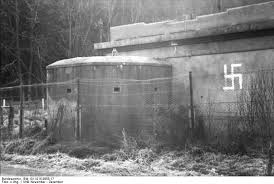29 October 2020
Hell and Heaven
A tale of two bunkers.
By Neil Tidmarsh
 Two competing visions of heaven and hell were revealed this week. The new hell is a very modern version of this ancient institution. The new heaven is a rather more traditional affair. But they both have shared roots in a common past.
Two competing visions of heaven and hell were revealed this week. The new hell is a very modern version of this ancient institution. The new heaven is a rather more traditional affair. But they both have shared roots in a common past.
First, the Hell. Traben-Trarbach is a pretty town near Koblenz in Germany. It sits on the River Moselle, surrounded by vineyards and overlooked by the picturesque ruins of a medieval castle. But beneath the surface an altogether uglier picture has emerged. Traben-Trarbach is also the site of a heavily-fortified military complex, built by the Nazis in the 1930’s (and hugely expanded in the 1970’s during the Cold War). Most of it is underground – a vast labyrinth of bunkers, tunnels and strongrooms. The German army decommissioned the site earlier this century and sold it in 2013 to a group of businessmen who turned it into a computer centre known as the “cyberbunker”.
A year ago, however, the cyberbunker was raided by the police (650 officers were involved) and closed down. And this week a court in Berlin heard claims that it was in fact “one of Europe’s biggest hubs for the ‘dark web’ and a superhighway for at least a quarter of a million offences” (The Times). Eight men – three Germans, four Dutchmen and a Bulgarian – are accused of turning the Traben-Trabach complex into a ‘bullet-proof’ safe-haven for cyber-crime and renting out its facilities to criminals who secretly plied their on-line trade literally underground, out of reach and hidden away from the forces of law and order. The activities which the bunkers reportedly hosted included drug-dealing, selling counterfeit id papers, trading stolen credit card details, circulating illegal pornography, advertising the services of contract killers, etc, etc.
It’s a truly hellish vision for our times – an actual underworld where gangs of vicious criminals operate in underground secrecy, spreading evil through the hidden and forbidden zones of the internet to feed and exploit the darker side of human nature. It’s as if the site was nourished by its Nazi origins, as if Hitler’s regime left the place so well seeded and fertilised when it dug those bunkers almost a century ago that something of its evil nature survived and thrived down there in the underground darkness right up to our own age.
“History is the nightmare from which I am trying to awake” said Joyce’s Stephan Dedalus. It’s remarkable how Nazi Germany – the nightmare of the twentieth century – still haunts Europe here in the twenty-first century. It seems that its ghosts and spirits were potent enough down in the cyberbunker’s labyrinth, but there were visitations aplenty elsewhere this week: Dutch churches issuing an apology for not standing against the holocaust when Holland was occupied by Germany during World War II; neo-Nazis outlawed in Greece; notes hand-written by Hitler finding their way to auction in spite of protests from Jewish groups; a reality TV competition (carpentry rather than baking) axed from British television because one of the contestants allegedly had Nazi symbols tattooed all over his face. Is there no escape from this particular nightmare? Is there no way this hellish episode from the past can be transformed into a celestial vision for the future?
Well, those questions take us at last to the Heaven, via a second Nazi military complex. In 1942, the Nazis built a torpedo test station in the Baltic, half a kilometre off the Polish coast. Its unsightly ruins, rearing up out of the sea, can still be seen from the city of Gdynia. The Association of Polish Architects, however, has just awarded a top prize to Pawel Lisiak, an architectural graduate of the Wroclaw University of Technology, for his student project – which redesigns the ruin as a Franciscan monastery.
His plans would transform the bleak remains of a war-loving culture into a modern heaven, a sea-borne, light-filled retreat for peace-loving pilgrims. A clean, white, minimalist structure making the most of its views out to sea, it would be constructed of bricks made out of recycled plastic bottles. The torpedo hatch would become a light-flooded baptistry, a church would float on the sea, surrounded by a monastic house, a guest house, a fraternity house, a patio and a pier.
If the cyberbunker doubled-down on its sinister heritage and fed on its darkness, Pawel Lisiak’s project breaks free from it and transforms darkness into light. It remains to be built (perhaps it will never be built – after all, history teaches us that it’s easier to build a hell on earth than it is to build a heaven on earth), but the plan alone might help to sweeten Europe’s dreams and relegate the nightmare of Traben-Trarbach’s bunkers to the history books.


